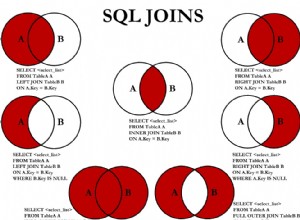AKTUALISIERUNG:
Weiter zum neuen Kommentar unten:
(
SELECT t.*, COUNT(*) AS tagcount
FROM tagged td
LEFT JOIN tags t ON (t.id = td.tag_id)
GROUP BY td.tag_id
ORDER BY tagcount DESC, t.title ASC
LIMIT 3
) ORDER BY title ASC;
Ergebnis:
+------+------------+----------+
| id | title | tagcount |
+------+------------+----------+
| 3 | javascript | 2 |
| 1 | mysql | 2 |
| 2 | php | 3 |
+------+------------+----------+
3 rows in set (0.00 sec)
Ändern Sie einfach das LIMIT 3 auf LIMIT 10 um die Top 10 statt der Top 3 zu bekommen.
Vorherige Antwort:
Warum fügen Sie nicht ein LIMIT 10 hinzu zu Ihrer Frage?
SELECT t.*, COUNT(*) AS tagcount
FROM tagged td
LEFT JOIN tags t ON (t.id = td.tag_id)
GROUP BY td.tag_id
ORDER BY tagcount DESC, t.title ASC
LIMIT 10;
Testfall:
CREATE TABLE tags (id int, title varchar(20));
CREATE TABLE tagged (tag_id int, post_id int);
INSERT INTO tags VALUES (1, 'mysql');
INSERT INTO tags VALUES (2, 'php');
INSERT INTO tags VALUES (3, 'javascript');
INSERT INTO tags VALUES (4, 'c');
INSERT INTO tagged VALUES (1, 1);
INSERT INTO tagged VALUES (2, 1);
INSERT INTO tagged VALUES (1, 2);
INSERT INTO tagged VALUES (2, 2);
INSERT INTO tagged VALUES (3, 3);
INSERT INTO tagged VALUES (2, 4);
INSERT INTO tagged VALUES (3, 4);
INSERT INTO tagged VALUES (4, 5);
Ergebnis (unter Verwendung von LIMIT 3 ):
+------+------------+----------+
| id | title | tagcount |
+------+------------+----------+
| 2 | php | 3 |
| 3 | javascript | 2 |
| 1 | mysql | 2 |
+------+------------+----------+
3 rows in set (0.00 sec)
Beachten Sie, wie der [c][code> -Tag fiel aus den Top-3-Ergebnissen heraus, und die Zeilen werden im Falle eines Gleichstands alphabetisch geordnet.




